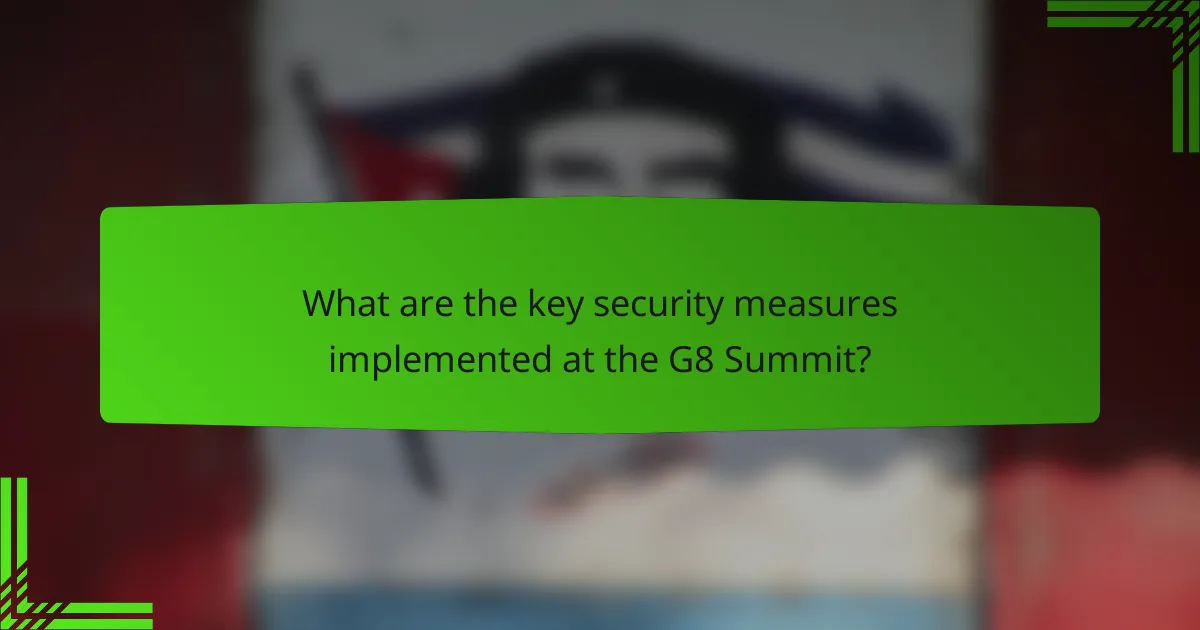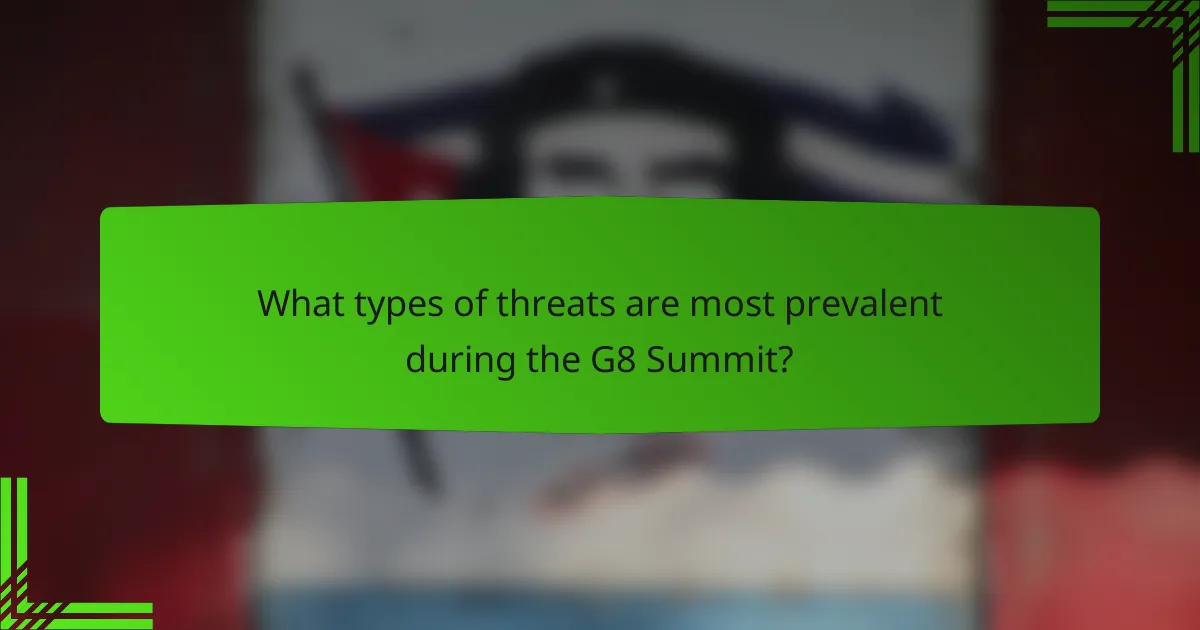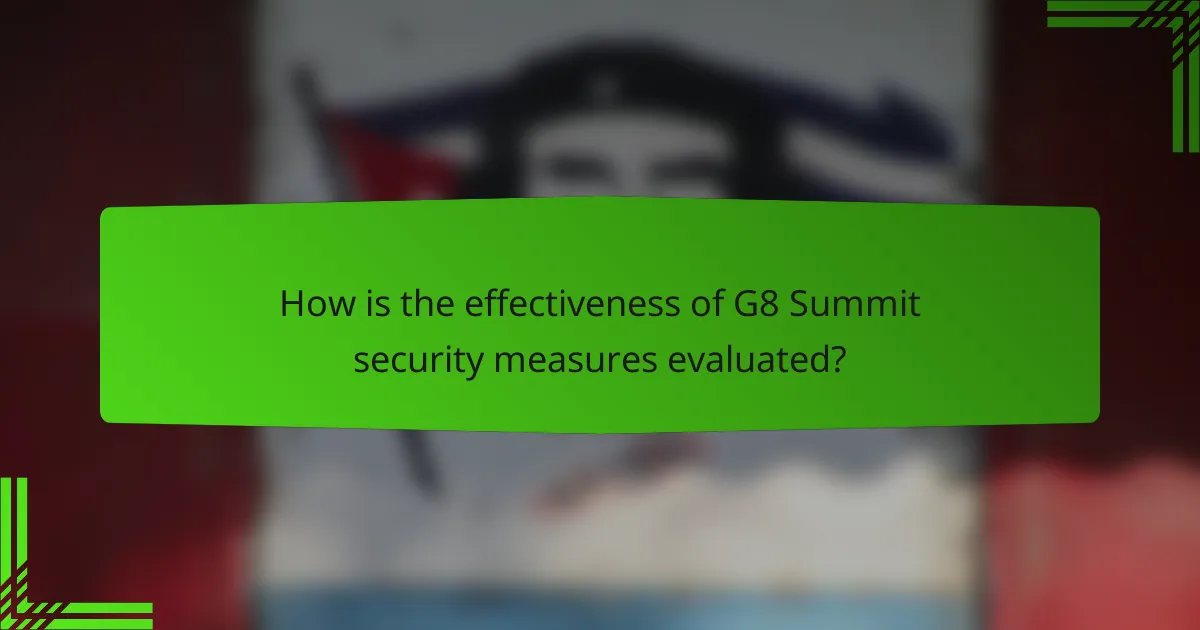The G8 Summit is a high-profile international meeting of world leaders, necessitating robust security measures to address various threats. Key security strategies include extensive surveillance through cameras and drones, controlled access for authorized personnel, and close coordination with local law enforcement agencies. Major threats during the summit encompass terrorism, protests, and cyber attacks, all of which require adaptive security responses. The effectiveness of these measures is assessed through risk evaluations, intelligence analysis, and post-event reviews, aimed at ensuring the safety of participants and preventing security breaches.

What are the key security measures implemented at the G8 Summit?
The key security measures implemented at the G8 Summit include extensive surveillance, controlled access, and coordination with local law enforcement. Surveillance systems utilize cameras and drones for real-time monitoring. Access to the summit venue is restricted to authorized personnel only. Attendees undergo thorough security checks to prevent unauthorized entry. Local law enforcement agencies collaborate with national security teams to enhance safety. Additionally, intelligence agencies monitor potential threats leading up to the event. These measures are designed to ensure the safety of leaders and participants during the summit.
How do these security measures address global threats?
These security measures address global threats by implementing comprehensive protocols and technologies. They enhance intelligence sharing among nations to identify and neutralize potential risks. The use of advanced surveillance systems monitors activities in real-time, providing immediate responses to threats. Coordination with international agencies ensures a unified approach to counter-terrorism efforts. Additionally, these measures include rigorous vetting processes for attendees, minimizing the risk of infiltration. Historical data shows that such protocols have successfully thwarted planned attacks during previous summits. For example, enhanced security at the 2013 G8 Summit in Northern Ireland resulted in no significant incidents. These strategies collectively bolster global security against evolving threats.
What specific global threats are considered during the planning of G8 Summit security?
The specific global threats considered during the planning of G8 Summit security include terrorism, cyber attacks, and geopolitical tensions. Terrorism poses a significant risk, as previous summits have been targets for extremist groups. Cyber attacks are also a concern, with potential disruptions to communication and critical infrastructure. Geopolitical tensions can escalate during the summit, necessitating heightened security measures. Additionally, natural disasters and health threats, such as pandemics, are assessed to ensure comprehensive safety. Historical incidents, like the 2001 G8 Summit in Genoa, highlight the importance of addressing these threats effectively.
How do these measures evolve in response to changing threat landscapes?
Security measures evolve continuously to address changing threat landscapes. These adaptations are driven by emerging risks, technological advancements, and historical incidents. For example, after the 9/11 attacks, security protocols at global summits became more stringent. Enhanced screening processes and surveillance technologies were implemented to counteract potential terrorist threats. Intelligence sharing among nations increased to improve response times and effectiveness. Additionally, the rise of cyber threats has led to the integration of cybersecurity measures into physical security protocols. Regular assessments of threat intelligence inform updates to security strategies. This dynamic approach ensures that security measures remain relevant and effective against evolving challenges.
What role does international cooperation play in G8 Summit security?
International cooperation is essential for G8 Summit security. It enhances intelligence sharing among member nations. Collaborative efforts help identify and mitigate potential threats. Joint security protocols are established to ensure a coordinated response. For example, during the 2013 G8 Summit in Northern Ireland, countries collaborated on counter-terrorism measures. This cooperation led to increased surveillance and rapid response capabilities. Historical instances show that unified action significantly reduces risks. The combined resources of member states strengthen overall security.
How do member countries collaborate on security protocols?
Member countries collaborate on security protocols through coordinated intelligence sharing and joint exercises. They establish frameworks for information exchange to enhance situational awareness. Regular meetings and summits facilitate discussions on emerging threats. Collaborative initiatives may include joint training programs and operational planning. Legal agreements also support cross-border cooperation in law enforcement. These efforts aim to create a unified response to global security challenges. Historical examples include the 2001 G8 Summit, which focused on counter-terrorism strategies. Such collaboration is essential for addressing complex security issues effectively.
What are the challenges of coordinating security among multiple nations?
Coordinating security among multiple nations presents significant challenges. These challenges include differing national interests and priorities. Each nation may have unique security concerns that complicate consensus. Language barriers can hinder effective communication and collaboration. Varying legal frameworks and regulations create obstacles in joint operations. Resource allocation issues may arise, as countries have different capabilities and funding levels. Trust deficits between nations can impede information sharing. Historical conflicts may influence current security cooperation efforts. These factors collectively complicate the establishment of cohesive security strategies.

What types of threats are most prevalent during the G8 Summit?
The most prevalent threats during the G8 Summit include terrorism, protests, and cyber attacks. Terrorism remains a primary concern due to the high-profile nature of the event. Historical instances, such as the 2001 Genoa Summit, highlight the potential for violent attacks. Protests often arise from various political and social issues, posing risks to security and logistics. Additionally, cyber attacks target sensitive information and infrastructure, as seen in previous summits. The convergence of world leaders attracts attention from extremist groups, increasing the likelihood of coordinated threats. Security measures are continuously updated to address these evolving risks.
How is terrorism specifically addressed in G8 Summit security measures?
Terrorism is addressed in G8 Summit security measures through enhanced international cooperation and intelligence sharing. Member countries commit to sharing information on terrorist threats and activities. They establish joint task forces to coordinate responses to terrorism. Security protocols are strengthened at venues hosting the summit. Comprehensive risk assessments are conducted prior to the event. Member states agree on counter-terrorism strategies to prevent attacks. They focus on protecting critical infrastructure from potential threats. These measures are part of a broader commitment to ensure the safety of participants and the public during the summit.
What are the historical examples of terrorism threats at previous G8 Summits?
Historical examples of terrorism threats at previous G8 Summits include various incidents. In 2001, the G8 Summit in Genoa faced violent protests and threats from anarchist groups. In 2003, the G8 Summit in Evian, France, heightened security due to potential threats from al-Qaeda. The 2005 G8 Summit in Gleneagles, Scotland, was marked by increased vigilance following the London bombings. In 2007, the summit in Heiligendamm, Germany, had elevated security measures due to concerns over radical groups. Each of these instances prompted significant security responses to mitigate risks.
How do intelligence sharing and surveillance contribute to counter-terrorism efforts?
Intelligence sharing and surveillance are critical components of effective counter-terrorism efforts. They enable agencies to gather and analyze data on potential threats. By sharing intelligence, countries can identify patterns and connections between terrorist activities across borders. Surveillance technologies provide real-time information on suspect movements and communications. This data helps law enforcement agencies prevent attacks before they occur. Historical examples, such as the collaboration between the United States and European nations post-9/11, demonstrate the effectiveness of intelligence sharing. Joint task forces have thwarted numerous plots through combined resources and information. Overall, these strategies enhance situational awareness and improve response times to emerging threats.
What are the implications of cybersecurity on G8 Summit security?
Cybersecurity significantly impacts G8 Summit security by safeguarding sensitive information and communications. A breach in cybersecurity can lead to the exposure of confidential discussions among leaders. This exposure may compromise diplomatic relations and national security. Cyber threats, such as hacking and data leaks, can disrupt the summit’s operations. Historical instances, like the 2015 G20 Summit, highlight the vulnerabilities of high-profile events to cyberattacks. Ensuring robust cybersecurity measures is essential for protecting the integrity of the summit. Consequently, nations invest in advanced cybersecurity protocols to mitigate these risks. Effective cybersecurity strategies enhance overall security and foster trust among participating countries.
How are cyber threats identified and mitigated during the summit?
Cyber threats during the summit are identified through continuous monitoring and analysis of network traffic. Security teams utilize advanced threat detection systems to identify anomalies. These systems analyze data patterns to flag suspicious activities. Additionally, real-time intelligence sharing occurs among participating nations. This collaborative approach enhances threat visibility and response. Cybersecurity experts conduct regular vulnerability assessments on summit-related systems. They also implement multi-layered security protocols to mitigate risks. For instance, firewalls and intrusion detection systems are deployed to protect sensitive information.
What technologies are utilized to enhance cybersecurity measures?
Technologies utilized to enhance cybersecurity measures include firewalls, intrusion detection systems, and encryption. Firewalls act as barriers between trusted and untrusted networks. They monitor and control incoming and outgoing network traffic. Intrusion detection systems detect unauthorized access and potential threats. They analyze network traffic for suspicious activity. Encryption secures data by converting it into a coded format. Only authorized users can access the original data. Additionally, multi-factor authentication adds layers of security by requiring multiple verification methods. Artificial intelligence is also employed to predict and respond to cyber threats in real-time. These technologies collectively strengthen cybersecurity frameworks against attacks.

How is the effectiveness of G8 Summit security measures evaluated?
The effectiveness of G8 Summit security measures is evaluated through various methods. These include risk assessments, intelligence analysis, and post-event reviews. Security agencies conduct risk assessments to identify potential threats. Intelligence analysis helps in monitoring activities related to the summit. Post-event reviews analyze the response to any incidents that occurred. Historical data from previous summits informs current security strategies. Evaluations also consider feedback from law enforcement agencies involved in security operations. The overall effectiveness is measured by the absence of security breaches or incidents during the summit.
What metrics are used to assess the success of security protocols?
Metrics used to assess the success of security protocols include incident response time, number of security breaches, and user compliance rates. Incident response time measures how quickly security teams react to threats. A shorter response time indicates more effective protocols. The number of security breaches reflects the effectiveness of preventive measures. Fewer breaches suggest stronger security protocols. User compliance rates gauge adherence to security policies. Higher compliance rates indicate successful implementation of security measures. These metrics collectively provide a clear picture of the protocols’ effectiveness in safeguarding against threats.
How do post-summit reviews influence future security planning?
Post-summit reviews influence future security planning by analyzing past security measures and identifying vulnerabilities. These reviews assess the effectiveness of security protocols implemented during the summit. They provide insights into potential threats that were not adequately addressed. By evaluating feedback from security personnel and stakeholders, planners can refine strategies for future events. Historical examples show that lessons learned from previous summits lead to improved security frameworks. For instance, the 2012 G8 Summit in Camp David resulted in enhanced protocols for subsequent events. This iterative process ensures that security planning evolves with emerging threats and challenges.
What feedback mechanisms are in place for continuous improvement?
Feedback mechanisms for continuous improvement in G8 Summit security measures include after-action reviews, stakeholder surveys, and intelligence assessments. After-action reviews analyze the effectiveness of security protocols post-event. Stakeholder surveys collect insights from participants and security personnel about their experiences. Intelligence assessments evaluate threat responses and identify areas for enhancement. These mechanisms ensure that lessons learned inform future security strategies. Historical data indicates that implementing such feedback loops can lead to improved safety outcomes at international events.
What best practices can be derived from G8 Summit security experiences?
Best practices derived from G8 Summit security experiences include comprehensive threat assessments and multi-agency collaboration. These practices ensure that potential risks are identified and addressed proactively. For instance, during the G8 Summit in 2001, extensive intelligence sharing among nations enhanced situational awareness. Coordinated security measures, such as joint drills, were implemented to prepare for various scenarios. Additionally, crowd control strategies were refined based on past events, ensuring public safety while maintaining order. The use of advanced surveillance technologies also proved effective in monitoring large gatherings. These practices have been adopted by various international events to enhance security protocols.
How can other events learn from G8 Summit security strategies?
Other events can learn from G8 Summit security strategies by implementing comprehensive risk assessments. The G8 Summit utilized extensive intelligence-sharing among nations to identify threats. This collaboration enabled proactive measures to mitigate risks. Additionally, the G8 employed layered security protocols, including perimeter security and access controls. These protocols ensured that only authorized personnel could enter sensitive areas. Furthermore, the use of advanced technology, such as surveillance systems, enhanced situational awareness. Training and coordination among security personnel were also emphasized, fostering a unified response to incidents. Lastly, post-event evaluations provided insights for continuous improvement in security measures.
What recommendations exist for enhancing future summit security?
Enhancing future summit security requires a multi-faceted approach. Recommendations include increasing intelligence sharing among nations. This can improve threat detection and response times. Implementing advanced surveillance technologies is also crucial. Drones and [censured] recognition systems can monitor large crowds effectively. Establishing a dedicated security task force can streamline operations. This task force should coordinate between local, national, and international agencies. Conducting regular security drills prepares personnel for potential threats. Engaging with cybersecurity experts protects against digital attacks. Lastly, fostering public awareness enhances community vigilance. These recommendations are based on successful practices observed in previous summits.
G8 Summit Security Measures are critical protocols designed to address global threats, including terrorism, cyber attacks, and geopolitical tensions. This article outlines the extensive security measures implemented at the G8 Summit, such as surveillance systems, controlled access, and international cooperation. It examines how these measures evolve in response to changing threat landscapes and evaluates their effectiveness through metrics and post-event reviews. Additionally, the article highlights best practices and recommendations for enhancing future summit security, emphasizing the importance of intelligence sharing and advanced technologies.